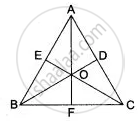Advertisements
Advertisements
प्रश्न
In Fig. AB = AC, BD and CE are the bisectors of ∠ABC and ∠ACB respectively such that BD and CE intersect each other at O. AO produced meets BC at F. Prove that AF is the right bisector of BC.
उत्तर
Given: A ΔABC in which AB = AC.
BD, the bisector of ∠ABC meets CE, the bisector of ∠ACB at O. AO produced meets BC at F.
To prove: AF is the right bisector of BC.
Proof: We have, AB = AC
⇒ A lies on the right bisector of BC ...(i)
and ∠ABC = ∠ACB
Now, ∠ABC = ∠ACB
⇒ `(1)/(2)`∠ABC = `(1)/(2)`∠ACB
⇒ ∠OBC = ∠OCB
[∵ BD and CE are bisector of ∠B and∠C respectively]
⇒ OB = OC
[∵ Sides opposite to equal angles are equal]
⇒ O lies on the right bisector of BC ...(iii)
From (i) and (ii), we obtain
⇒ A and O both lie on the right bisector of BC.
⇒ AO is the right bisector of BC
Hence, AF is the right bisector of BC.
Hence proved.
APPEARS IN
संबंधित प्रश्न
In parallelogram ABCD, side AB is greater than side BC and P is a point in AC such that PB bisects angle B. Prove that P is equidistant from AB and BC.
In triangle LMN, bisectors of interior angles at L and N intersect each other at point A. Prove that:
- Point A is equidistant from all the three sides of the triangle.
- AM bisects angle LMN.
Draw a line AB = 6 cm. Draw the locus of all the points which are equidistant from A and B.
Describe the locus of points at distances greater than or equal to 35 mm from a given point.
In Δ ABC, the perpendicular bisector of AB and AC meet at 0. Prove that O is equidistant from the three vertices. Also, prove that if M is the mid-point of BC then OM meets BC at right angles.
In a quadrilateral PQRS, if the bisectors of ∠ SPQ and ∠ PQR meet at O, prove that O is equidistant from PS and QR.
In a quadrilateral ABCD, if the perpendicular bisectors of AB and AD meet at P, then prove that BP = DP.
Find the locus of points which are equidistant from three non-collinear points.
Show that the locus of the centres of all circles passing through two given points A and B, is the perpendicular bisector of the line segment AB.
ΔPBC and ΔQBC are two isosceles triangles on the same base BC but on the opposite sides of line BC. Show that PQ bisects BC at right angles.
